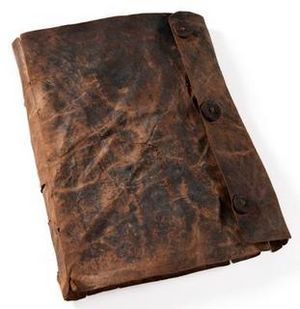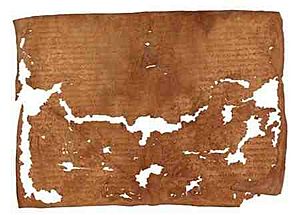Faddan More Psalter facts for kids
The Faddan More Psalter (also called the Irish Bog Psalter) is a very old Christian book of Psalms. It was found in July 2006 in a peat bog in Faddan More, a townland in north County Tipperary, Ireland. This special book was likely written around 800 CE in a monastery nearby. After many years of careful work to preserve it, the psalter went on display at the National Museum of Ireland – Archaeology in Dublin in June 2011.
Experts at the National Museum of Ireland called this discovery one of the most important archaeological finds in Ireland for many decades. Bernard Meehan, an expert from Trinity College Library, said he believed it was the first time an early medieval Irish manuscript had been found in 200 years. During the preservation work from 2006 to 2010, scientists found that the inside of the leather cover was lined with papyrus. This papyrus was probably used to make the cover stiffer. Some people think this shows that Irish Christian groups had connections with the Coptic churches in Egypt at that time.
The Faddan More Psalter is one of only a few very old Western books that have survived completely with their original bookbindings. Most of these books come from monasteries in Britain and Ireland, known for their Insular art. They also come from Christian missions that spread across Europe. The oldest example is the St Cuthbert Gospel from about 700 CE. Other similar books from the mid-8th century are found in Fulda, Germany. However, the Faddan More Psalter's cover is unique. It looks like a wallet and doesn't seem to have been fully attached to the pages inside.
Contents
What the Psalter Looks Like
The psalter contains the Latin words of the Psalms. It has 60 sheets of vellum (a type of parchment made from animal skin) grouped into five sections. The text is a common Latin version of the Bible, written in large, clear Insular majuscule letters in a single column. The first letter of each psalm is a capital letter. Also, the first words of Psalms 1, 51, and 101 are decorated with black, red, and yellow colors.
The original leather cover has a flap that folds over. This flap has three buttons made of horn. These buttons were probably used to hold a missing strap or thong that tied the cover shut. The cover did not seem to be directly attached to the pages inside. It worked more like a folder or a wallet. Some old pictures in other manuscripts show similar covers, but no other real covers like this have survived. The outside of the cover was painted with black carbon. The leather itself might have been used as a practice piece for designing interlace patterns for other items. Inside, there is a sheet of papyrus, which likely helped to stiffen the cover.
The bog's low oxygen levels helped to preserve the psalter in an amazing way. Irish monks often used bogs to hide valuable items from Viking raiders. Besides low oxygen, the sphagnum moss in the peat bog creates a special substance called sphagnan. This substance stops tiny living things from causing decay. It also changes chemicals and nutrients that would normally break down organic matter. Most importantly, the sphagnum moss causes the organic material itself to change, making it resistant to rot.
How It Was Found
The psalter was discovered by Eddie Fogarty, a bulldozer driver who was digging for peat with a backhoe. Patrick Wallace, the director of the National Museum, praised Fogarty. He immediately covered the book with damp soil. This was very important because if the book had been exposed to dry air after so many centuries in dampness, it might have been destroyed. The book was first kept cold in a refrigerator at the National Museum.
Experts thought it would take months to find the safest way to open the pages without damaging them. The full preservation work was expected to take two years. The area around Faddan More Bog has a rich medieval history. Many old monasteries, like Lorrha and Terryglass in County Tipperary, and Birr and Seirkieran in County Offaly, are located nearby.
The bog belongs to local brothers, Kevin and Patrick Leonard. Six years before the psalter was found, a leather satchel was discovered nearby. Radiocarbon dating showed this satchel was from between the seventh and ninth centuries. It was found only about 100 meters (328 feet) from where the psalter was discovered. Since they are from a similar time, the satchel might have originally held the book. Also, before 2006, two ancient wooden containers were found in the same bog.
A Misunderstanding About a Psalm
When the book was found, it was open to a page showing Psalm 83 (using the Septuagint numbering). This is Psalm 84 in the Masoretic numbering, which is used in most English Bibles. Because of confusion about these different ways of numbering the Psalms, some news websites incorrectly said the psalter was open to Masoretic Psalm 83. That psalm talks about enemies trying to destroy Israel. This made some people connect the book's discovery with a conflict happening in 2006.
The director of the National Museum of Ireland later explained the difference in numbering. He pointed out that the psalm shown in the book did not talk about the destruction of Israel.
Saving the Psalter
The psalter was in poor condition because of the acidic peat bog. However, the bog was also what had preserved it. It was in such bad shape that someone at the British Museum even put a picture of it in a staff area with the caption, "if you think you have a bad day ahead..."
The National Museum of Ireland asked experts in saving old objects and books for advice. They received some different ideas. Finally, they decided on a multi-step plan to preserve the psalter. The first step was to examine the psalter without touching it, using things like photography, MRI scans, and checking the binding.
In the second step, they experimented with 18th-century parchments to find the best way to dry parchment that had been soaked in water. The most effective method involved soaking the parchment in ethanol (alcohol) to replace the water. Then, they placed it between blotting sheets and sealed it in a vacuum pack.
In the third step, this method was tested on small pieces of the psalter and worked well. Conservators then started using this method on larger parts of the psalter. They found they could consistently keep the shrinkage of the parchment to only 2–5%. In comparison, a small piece that was air-dried shrank by 75%.
Removing the water took four years, using a vacuum chamber to prevent shrinkage and decay. After that, the book was carefully taken apart. The letters, written in iron gall ink, were preserved better than the spaces between them, which had often dissolved. So, after drying, it was necessary to put the pieces back together in the correct order. The whole process was described in a book from the National Museum of Ireland, called The Faddan More Psalter, The Discovery and Conservation of a Medieval Treasure, published in November 2021.
See also
- Cathach of St. Columba, a 6th-century Irish psalter
- Springmount Bog Tablets, 7th-century Irish psalter written on wooden wax tablets
- Clonycavan Man and Old Croghan Man, other interesting finds from Irish bogs in 2003



